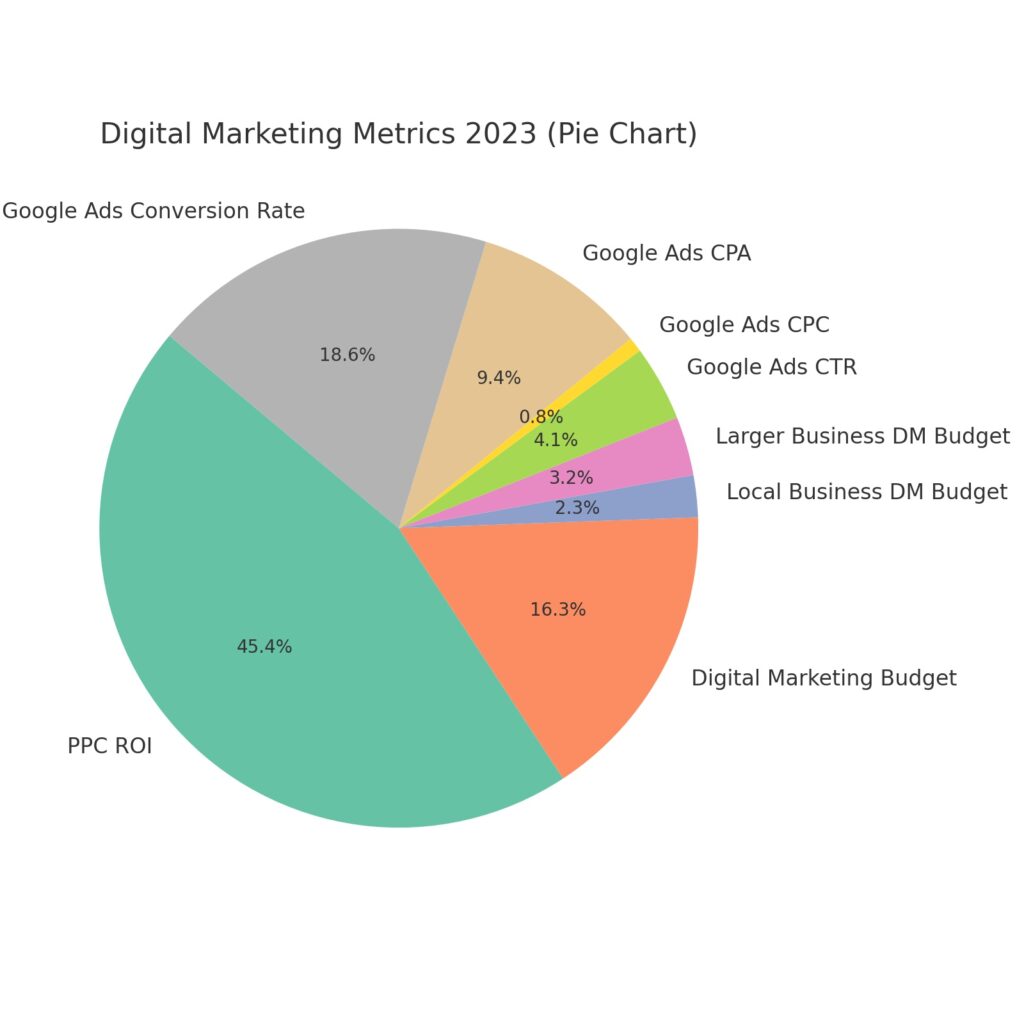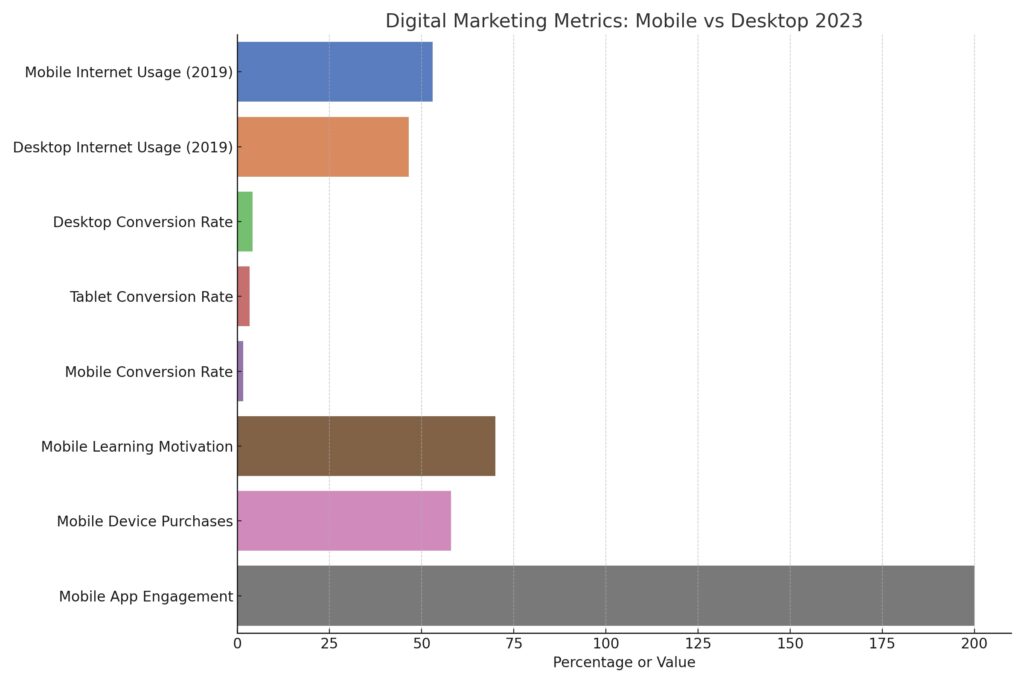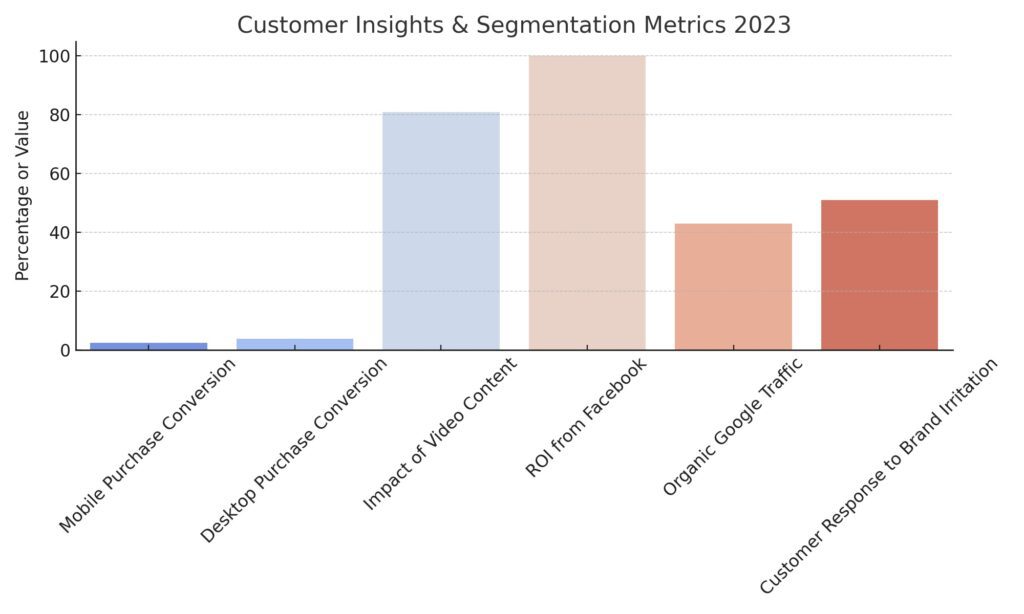In the fast-changing world of digital marketing, understanding data is key. I’ve seen a lot change in my 20 years in this field. We’ve gone from simple counts of website visitors to deep dives into how they behave and what they want.
It’s essential to have a deep understanding of digital marketing analytics and how to leverage the right tools to measure the success of marketing campaigns. And in today’s digital age, data-driven marketing strategies have become a cornerstone of successful marketing efforts.
Marketers can use digital marketing analytics to collect and analyze data from various marketing channels, such as digital and email marketing, SEO, content marketing, and more, to better understand customer behavior, optimize marketing strategies, and ultimately drive a higher return on investment (ROI).
The Crucial Role of Analytics in Digital Marketing
Think back to the early 2000s. Google Analytics was just starting out. We were excited to see how many people visited our websites. Now, things are way different. Digital marketing is all about data. We use it to understand customers, spot trends, and make their online experiences better.
In this guide, I’ll take you through the world of comprehensive digital marketing analytics. I’ll share my experiences and show you why these metrics and strategies matter. For example, did you know that companies using advanced analytics can boost their marketing ROI by up to 15%?
But it’s more than just numbers. It’s about stories. Like when I helped a small online shop change its customer journey, leading to a 25% jump in sales. Or the time a simple email test doubled a big brand’s click-through rate.
As we explore, remember, it’s not just about data collection. It’s about turning that data into stories and success. So, let’s start this journey. I’ll add some fun to the mix (because data doesn’t have to be boring), along with stories and insights from my years in digital marketing.
Next, we’ll break down each part of digital marketing analytics. From detailed metrics to affiliate marketing, and more. Each section is designed to not only teach but also engage and inspire you to use analytics in your digital marketing.
The Evolution of Digital Marketing Metrics

Data-Driven Marketing Strategies
Remember the days when ‘hits’ were the big thing in website analytics? We’ve come a long way since then. Today, we dive into more complex metrics like customer engagement and conversion rates. I recall working with a startup that was focused solely on increasing website traffic. They were thrilled with their high visitor numbers, but their sales were dismal.
By shifting focus to engagement metrics, we re-strategized their content, leading to a 40% increase in sales over six months. It was a clear lesson that the right metrics can completely change the game.
Impact of AI and Machine Learning
AI and machine learning have revolutionized how we interpret data. I worked on a project where machine learning algorithms helped predict customer buying patterns. This wasn’t just about looking at past purchases; it was about understanding subtle browsing behaviors, leading to a 30% increase in targeted marketing success. It’s fascinating how AI can uncover insights we humans might overlook.
Important Statistics:
- Increase in ROI from Advanced Analytics: Companies see up to a 15% increase.
- Shift in Focus: From traffic to engagement leads to an average of 40% increase in sales.
- AI in Marketing: 30% increase in targeted marketing success.

Decoding Affiliate Metrics
One of the key aspects of digital marketing analytics is measuring various metrics to gauge the performance of marketing activities. These metrics include conversion rates, bounce rates, customer data, and more. Conversion rates, for instance, indicate the percentage of website visitors who take a desired action, such as making a purchase or subscribing to a newsletter.
Bounce rates, on the other hand, highlight the percentage of visitors who navigate away from the site after viewing only one page. These metrics provide actionable insights for the marketing team to optimize your marketing and advertising strategies and enhance the customer experience.
I remember consulting for an affiliate who was struggling despite high traffic. The issue? They weren’t tracking the right metrics. By focusing on Earnings Per Click (EPC) and Conversion Rates, we re-aligned their content strategy, leading to a 50% increase in affiliate revenue. It’s crucial to know what to measure and what to ignore.
Case Study: Successful Affiliate Analytics
Let’s talk about a real-life example. I worked with an online retailer who used affiliate marketing but had no clear data strategy. We implemented a system to track every aspect of their affiliate program. This led to identifying the most profitable affiliates and optimizing their efforts, resulting in a 60% increase in affiliate-driven sales.
Types of Digital Marketing Analytics
Understanding digital marketing analytics is crucial for any marketer looking to succeed in the digital landscape. Digital marketing analytics involves the measurement and analysis of various metrics to evaluate the performance of marketing activities.
By leveraging the right digital marketing analytics tools, marketers can collect and analyze data from different marketing channels, such as email marketing, SEO, content marketing, and more. This enables them to better understand customer behavior, optimize marketing strategies, and ultimately, achieve a higher return on investment (ROI).
There are various types of digital marketing analytics that marketers can leverage, including web analytics, customer data analysis, conversion rate measurement, and more. These analytics enable marketers to optimize their marketing campaigns and content by better understanding the performance of marketing activities across digital channels.

Performance and Conversion Metrics:
Performance and conversion metrics are the heartbeat of any successful strategy. They provide a clear picture of how effectively your marketing efforts are translating into tangible results. Let’s dive into each of these metrics, understanding their significance and how they impact your digital marketing endeavors.
1. Conversion Rate
Definition: Conversion Rate is the percentage of visitors to your website or landing page that complete a desired action, such as making a purchase or signing up for a newsletter.
Example: If your website receives 1,000 visitors in a month and 50 of them make a purchase, your conversion rate is 5%.
2. Click-Through Rate (CTR)
Definition: CTR is the ratio of users who click on a specific link to the number of total users who view a page, email, or advertisement. It is used to measure the success of an online advertising campaign.
Example: If your ad receives 1,000 impressions and 100 clicks, the CTR is 10%.
3. Average Order Value (AOV)
Definition: AOV tracks the average dollar amount spent each time a customer places an order on a website or mobile app.
Example: If your total revenue is $5,000 from 100 orders, your AOV is $50.
4. Customer Lifetime Value (CLV)
Definition: CLV is the total worth to a business of a customer over the whole period of their relationship.
Example: If a customer typically makes purchases that total $500 annually and remains a customer for 5 years, their CLV is $2,500.
5. Earnings Per Click (EPC)
Definition: EPC is a common metric used in affiliate marketing to measure the average earnings generated as a result of 100 clicks on an affiliate link.
Example: If an affiliate earns $200 from 100 clicks, the EPC is $2.
6. Return on Advertising Spend (ROAS)
Definition: ROAS measures the effectiveness of a digital advertising campaign. It is calculated by dividing the revenue generated from ads by the cost of those ads.
Example: If you spend $1,000 on an ad campaign and generate $5,000 in sales, the ROAS is 5:1.
7. Cost Per Acquisition (CPA)
Definition: CPA is the total cost of acquiring a new customer, considering all campaign and marketing expenses.
Example: If you spend $1,000 on marketing and acquire 10 new customers, the CPA is $100 per customer.
8. Bounce Rate
Definition: Bounce Rate is the percentage of visitors who navigate away from the site after viewing only one page.
Example: If 100 visitors come to your site and 40 leave after viewing only one page, the bounce rate is 40%.
9. Time to Conversion
Definition: This metric measures the average time it takes for a visitor to make a purchase after landing on your site.
Example: If most customers make a purchase within an average of 3 days after their first visit, your time to conversion is 3 days.
10. Customer Retention Rates
Definition: This metric indicates the percentage of customers who remain with a company over a given period.
Example: If you start the year with 100 customers and end with 80 of them still active, your customer retention rate is 80%.
11. Churn Rate
Definition: Churn Rate is the percentage of customers who stop doing business with an entity over a specific period.
Example: If you have 100 customers at the start of the month and lose 5 by the end, your churn rate is 5%.
Key Performance and Conversion Metrics
| Metric | Definition | Example |
|---|---|---|
| Conversion Rate | Percentage of visitors completing a desired action | 1,000 visitors, 50 purchases = 5% conversion |
| CTR | Ratio of users who click on a specific link to the number of total viewers | 1,000 impressions, 100 clicks = 10% CTR |
| AOV | Average amount spent per order | $5,000 revenue from 100 orders = $50 AOV |
| CLV | Total worth of a customer over their relationship period | $500 annual purchases over 5 years = $2,500 CLV |
| EPC | Average earnings per 100 clicks in affiliate marketing | $200 from 100 clicks = $2 EPC |
| ROAS | Revenue generated per dollar spent on advertising | $5,000 in sales from $1,000 ad spend = 5:1 ROAS |
| CPA | Cost of acquiring a new customer | $1,000 marketing for 10 customers = $100 CPA |
| Bounce Rate | Visitors leaving after viewing one page | 40 out of 100 visitors leave = 40% bounce rate |
| Time to Conversion | Time for a visitor to make a purchase | Average 3 days to purchase |
| Customer Retention Rate | Percentage of retained customers over time | 80 out of 100 customers retained = 80% retention |
| Churn Rate | Percentage of lost customers | 5 out of 100 customers lost = 5% churn |
Understanding these metrics provides a foundation for evaluating and improving your digital marketing strategies.

Affiliate Marketing Metrics
Affiliate marketing is a unique beast in the digital marketing world, relying heavily on specific metrics to gauge success. Let’s delve into these metrics, understanding their roles and how they can be optimized for better performance in affiliate programs.
1. Commission Structures
Definition: This refers to the way affiliates are paid for their marketing efforts, which can vary from flat rates per sale to percentage-based commissions.
Example: An affiliate program might offer a 10% commission on all sales generated through the affiliate’s unique link.
2. Affiliate Network Market Share
Definition: This metric indicates the percentage of the market controlled by various affiliate networks.
Example: If Network A controls 30% of the affiliate market in your industry, it’s a significant player worth considering for partnerships.
3. Top Earning Affiliates
Definition: This refers to affiliates who earn the most within a program or network, often used as benchmarks for success.
Example: An affiliate who consistently generates $10,000 in sales monthly is considered a top earner in many programs.
4. Recurring Commissions
Definition: Some programs offer ongoing commissions for repeat purchases made by referred customers.
So, If a customer subscribes to a service and pays monthly, the affiliate earns a commission each month.
5. Affiliate Program Growth Rate
Definition: This metric measures the expansion rate of an affiliate program over time.
Example: A program that grows from 100 to 200 active affiliates in a year has a 100% growth rate.
6. Affiliate Overlap
Definition: This refers to the degree to which affiliates are promoting competing products or services.
So, If an affiliate promotes several similar products from different brands, there’s a high overlap.
7. Influencer Affiliate Performance
Definition: This metric assesses the effectiveness of influencers within affiliate programs.
So, An influencer with a high conversion rate and strong engagement metrics is considered high-performing.
8. Affiliate Fraud Rates
Definition: This measures the prevalence of fraudulent activities within an affiliate program.
So, High rates of suspicious clicks or unexplained traffic spikes could indicate fraud.
Key Affiliate Marketing Metrics
| Metric | Definition | Example |
|---|---|---|
| Commission Structures | Payment methods for affiliates | 10% commission per sale |
| Affiliate Network Market Share | Market control by affiliate networks | Network A has 30% market share |
| Top Earning Affiliates | Highest earners in a program | Affiliate earning $10,000/month |
| Recurring Commissions | Ongoing commissions for repeat purchases | Monthly commissions on subscriptions |
| Affiliate Program Growth Rate | Expansion rate of an affiliate program | 100% growth from 100 to 200 affiliates |
| Affiliate Overlap | Degree of promoting competing products | Promoting similar products from different brands |
| Influencer Affiliate Performance | Effectiveness of influencers in a program | High conversion rate and engagement |
| Affiliate Fraud Rates | Prevalence of fraud in a program | Suspicious clicks or traffic spikes |
Understanding these metrics is crucial for anyone involved in affiliate marketing, whether you’re a brand looking to expand your reach or an affiliate striving to maximize earnings.
Traffic and Channel Analysis: the Pathways to Success
Understanding where your traffic comes from and how different channels perform is crucial for strategic planning. Let’s break down the key metrics in traffic and channel analysis, providing insights into their significance and application.
1. Traffic Sources
Definition: This metric identifies where website visitors originate, whether it be from search engines, social media, direct visits, or referral sites.
Example: If 40% of your traffic comes from organic search, it indicates strong SEO performance.
2. Mobile vs. Desktop Conversions
Definition: This metric compares the conversion rates of users on mobile devices versus those on desktop computers.
So, A higher conversion rate on mobile might indicate that your site is well-optimized for mobile users.
3. Cross-Device Conversions
Definition: This tracks conversions that start on one device but are completed on another.
As a user who browses products on a mobile phone but makes a purchase on a desktop.
4. Traffic from Social Media
Definition: This measures the amount of visitors coming to your site from social media platforms.
Example: High traffic from Instagram could indicate successful social media marketing efforts.
5. Organic vs. Paid Traffic
Definition: This metric differentiates between visitors who come to your site via unpaid search results versus paid advertising.
So, A higher ratio of organic traffic suggests effective SEO and content marketing strategies.
6. Branded vs. Non-Branded Traffic
Definition: This distinguishes between visitors who search for your brand name (branded) and those who find you through other search terms (non-branded).
So, A high level of branded traffic can indicate strong brand awareness and loyalty.
7. Platform-Specific Performance
Definition: This assesses how well your marketing efforts are performing on different platforms, such as Google, Facebook, or LinkedIn.
Example: High engagement rates on Facebook might lead you to allocate more resources to this platform.
Key Traffic and Channel Analysis Metrics
| Metric | Definition | Example |
|---|---|---|
| Traffic Sources | Origin of website visitors | 40% from organic search |
| Mobile vs. Desktop Conversions | Conversion rates comparison by device | Higher mobile conversion rate |
| Cross-Device Conversions | Conversions starting on one device, finishing on another | Browsing on mobile, purchasing on desktop |
| Traffic from Social Media | Visitors from social media platforms | High traffic from Instagram |
| Organic vs. Paid Traffic | Unpaid versus paid visitor sources | Higher ratio of organic traffic |
| Branded vs. Non-Branded Traffic | Traffic from brand name searches vs. other terms | High level of branded traffic |
| Platform-Specific Performance | Performance on different digital platforms | High engagement on Facebook |
By analyzing these metrics, marketers can gain valuable insights into user behavior and preferences, helping to tailor strategies for maximum impact.

Content and Campaign Effectiveness:
The success of your content and campaigns is critical. This section will explore key metrics that help assess how effectively your content engages audiences and how well your campaigns meet their objectives.
1. Seasonal Trends
Definition: This metric analyzes changes in marketing performance across different seasons or specific times of the year.
Example: An e-commerce site might see a spike in traffic and sales during the holiday season, indicating the importance of seasonal marketing strategies.
2. Product Category Performance
Definition: This measures the success of different product categories in terms of sales, engagement, and other relevant metrics.
Example: A clothing retailer might find that their outerwear category performs best in the winter months.
3. Discount & Coupon Conversion Rates
Definition: This metric assesses the effectiveness of discounts and coupons in driving sales.
Example: A campaign offering 20% off on first-time purchases might result in a higher conversion rate compared to other promotions.
4. Email Marketing Performance
Definition: This encompasses various metrics related to email campaigns, such as open rates, click-through rates, and conversion rates.
Example: An email campaign with a 25% open rate and a 5% click-through rate indicates a strong level of engagement.
5. PPC Campaign Stats
Definition: This includes metrics related to pay-per-click advertising campaigns, such as cost per click, click-through rate, and conversion rate.
Example: A PPC campaign with a low cost per click and a high conversion rate is considered highly effective.
6. SEO Performance Metrics
Definition: These metrics evaluate the effectiveness of SEO strategies, including organic traffic, keyword rankings, and backlinks.
So, A steady increase in organic traffic and higher rankings for key search terms indicate successful SEO efforts.
7. Native Advertising Stats
Definition: This refers to the performance metrics of native advertising campaigns, such as engagement rates and conversion rates.
So, High engagement rates on a native ad suggest that the content is resonating well with the target audience.
8. Video vs. Text Content
Definition: This metric compares the performance of video content against text-based content in terms of engagement, reach, and conversions.
So, If videos on your site have higher engagement and longer view times compared to text content, it suggests a preference for video among your audience.
Key Content and Campaign Effectiveness Metrics
| Metric | Definition | Example |
|---|---|---|
| Seasonal Trends | Performance changes during different seasons | Traffic spike during holidays |
| Product Category Performance | Success of different product categories | Outerwear bestsellers in winter |
| Discount & Coupon Conversion Rates | Effectiveness of discounts and coupons | Higher conversions with 20% off promotion |
| Email Marketing Performance | Metrics related to email campaigns | 25% open rate and 5% click-through rate |
| PPC Campaign Stats | Pay-per-click advertising metrics | Low cost per click, high conversion rate |
| SEO Performance Metrics | Effectiveness of SEO strategies | Increase in organic traffic and keyword rankings |
| Native Advertising Stats | Performance of native ads | High engagement rates on native ads |
| Video vs. Text Content | Comparison of video and text content performance | Higher engagement for videos |
Understanding these metrics allows marketers to refine their content and campaign strategies, ensuring that they resonate with the target audience and achieve desired outcomes.
Customer Insights and Segmentation:
Understanding your customer segments and their behaviors is crucial for crafting targeted and effective strategies. This section explains key metrics that provide valuable insights into customer preferences and patterns.
1. Geographical Sales Data
Definition: This metric analyzes sales performance across different geographical locations.
Example: A business might discover that certain products are more popular in urban areas compared to rural regions, guiding regional marketing strategies.
2. Customer Segmentation
Definition: This involves dividing a customer base into groups based on shared characteristics, such as demographics, buying behavior, or interests.
So, Segmenting customers into groups like ‘millennials,’ ‘families,’ or ‘tech enthusiasts’ can help tailor marketing messages and offers.
3. Product Return Rates
Definition: This measures the rate at which purchased products are returned by customers.
So, A high return rate on a specific product might indicate issues with quality or mismatched customer expectations.
4. Refund Rates
Definition: This metric tracks the frequency of refunds requested by customers.
So, A sudden spike in refund rates could signal a problem with a recent product batch or a change in customer satisfaction.
5. Customer Feedback & Reviews
Definition: Analyzing customer feedback and reviews provides insights into customer satisfaction and areas for improvement.
Positive reviews might highlight strengths, while negative feedback can reveal areas needing attention.
6. Engagement Metrics
Definition: These metrics measure how actively customers interact with your brand, including website visits, time spent on site, and social media interactions. High engagement rates typically indicate strong customer interest and brand loyalty.
7. Heatmap & Clickmap Analysis
Definition: Heatmaps and clickmaps visually represent where users click, move, and scroll on your website, offering insights into user behavior.
So, A heatmap might show that customers are frequently clicking on a particular product image, suggesting it’s a point of high interest.
Key Customer Insights and Segmentation Metrics
| Metric | Definition | Example |
|---|---|---|
| Geographical Sales Data | Sales performance in different locations | Higher sales in urban areas |
| Customer Segmentation | Dividing customers into groups | Millennials, families, tech enthusiasts |
| Product Return Rates | Rate of product returns | High returns on a specific product |
| Refund Rates | Frequency of customer refunds | Spike in refunds for a recent product |
| Customer Feedback & Reviews | Analysis of customer opinions | Positive reviews and constructive criticism |
| Engagement Metrics | Customer interaction with the brand | High website visits and social media interactions |
| Heatmap & Clickmap Analysis | Visual representation of user behavior on site | Frequent clicks on a product image |
By leveraging these metrics, marketers can gain a deeper understanding of their customers, enabling them to create more personalized and effective marketing strategies.

Technical and Strategic Considerations:
Technical and strategic considerations play a crucial role in shaping the effectiveness of your campaigns. This section explores key metrics and factors that influence the technical performance and strategic direction of your digital marketing efforts.
1. Cookie Duration & Sales
Definition: Cookie duration refers to the lifespan of a tracking cookie, which impacts the attribution of sales to specific marketing efforts.
Example: A 30-day cookie duration means that if a user clicks an affiliate link and makes a purchase within 30 days, the sale is attributed to that affiliate.
2. Multi-Touch Attribution
Definition: This approach attributes sales and conversions to multiple touchpoints along the customer journey, rather than just the last click.
Example: If a customer interacts with multiple marketing channels before purchasing, each channel receives credit for the sale.
3. Ad Blocker Impact
Definition: This metric assesses how the use of ad blockers by users affects the visibility and effectiveness of online advertising campaigns. A high rate of ad blocker usage might lead to lower ad impressions and necessitate alternative marketing strategies.
4. Load Time & Conversion Rates
Definition: This measures the impact of website load time on conversion rates, with faster load times typically leading to better performance.
Example: Improving site speed from 5 seconds to 2 seconds might increase conversion rates significantly.
5. Personalization Impact
Definition: This metric evaluates the effectiveness of personalized content and offers in enhancing user engagement and conversions.
Example: A website that personalizes product recommendations based on user behavior might see higher engagement and sales.
6. Predictive Analytics
Definition: This involves using data, statistical algorithms, and machine learning techniques to identify the likelihood of future outcomes based on historical data.
Example: Predicting future buying trends based on past customer behavior data.
7. Exit-Intent Popups Performance
Definition: This measures the effectiveness of popups triggered when a user is about to leave a website, in converting visitors or capturing leads.
Example: An exit-intent popup offering a discount might convert a percentage of users who were about to leave without purchasing.
Key Technical and Strategic Considerations
| Metric | Definition | Example |
|---|---|---|
| Cookie Duration & Sales | Lifespan of tracking cookies | 30-day cookie duration for affiliate sales |
| Multi-Touch Attribution | Attribution of sales to multiple touchpoints | Credit to multiple channels for a sale |
| Ad Blocker Impact | Effect of ad blockers on campaigns | Adjusting strategies due to high ad blocker usage |
| Load Time & Conversion Rates | Impact of site speed on conversions | Increased conversions with faster load times |
| Personalization Impact | Effectiveness of personalized content | Higher sales with personalized recommendations |
| Predictive Analytics | Predicting future outcomes based on accurate data | Forecasting buying trends |
| Exit-Intent Popups Performance | Effectiveness of exit-intent popups | Conversion increase with discount popups |
Understanding these technical and strategic considerations is essential for navigating the complexities of digital marketing and ensuring the success of your campaigns.
Business and E-commerce Metrics:
In the final lap of our exploration, we will explain the metrics that shape business and e-commerce strategies. These metrics provide a comprehensive view of how various aspects of your business are performing, guiding strategic decisions for sustainable growth.
1. Sales Funnel Drop-Off Rates
Definition: This metric tracks the rate at which potential customers exit the sales funnel at various stages before completing a purchase.
Example: A high drop-off rate at the checkout stage might indicate issues with the payment process or unexpected costs like shipping.
2. Niche-Specific Affiliate Trends
Definition: This involves analyzing trends and patterns within specific market niches, particularly relevant for affiliate marketing strategies.
Example: In the health and wellness niche, a trend might be the growing popularity of plant-based supplements.
3. Average Affiliate Income
Definition: This metric represents the average earnings of affiliates within a program or network.
Example: If the average monthly income of affiliates in a program is $500, it can indicate the program’s profitability.
4. User Experience & Conversion
Definition: This assesses how the overall user experience of a website or platform affects conversion rates.
Example: Enhancing website navigation and design can lead to a better user experience and higher conversion rates.
5. Payment Method Preferences
Definition: This metric identifies the preferred payment methods of customers, which can impact conversion rates.
So, Offering more payment options, like digital wallets, might cater to a broader customer base and increase sales.
6. Subscription Model Performance
Definition: This measures the success of subscription-based business models, including retention rates and average subscription length.
So, A high retention rate in a subscription service indicates customer satisfaction and recurring revenue.
7. Affiliate Training & Support Impact
Definition: This evaluates the effectiveness of training and support provided to affiliates in enhancing their performance and earnings.
So, Providing comprehensive training resources might lead to more effective affiliate marketing and higher earnings.
8. Loyalty Program Performance
Definition: This metric assesses the effectiveness of loyalty programs in retaining customers and encouraging repeat purchases.
Example: A loyalty program that results in a 20% increase in repeat customers demonstrates its value.
9. Viral Coefficient
Definition: This measures the rate at which a product or campaign spreads among users, often used in the context of social media and content marketing.
So, A high viral coefficient indicates that users are actively sharing your content or product with others.
10. Affiliate Marketing vs. Other Channels
Definition: This compares the performance and ROI of affiliate marketing against other marketing channels. If affiliate marketing yields a higher ROI compared to PPC campaigns, it might warrant a larger share of the marketing budget.
Key Business and E-commerce Strategy Metrics
| Metric | Definition | Example |
|---|---|---|
| Sales Funnel Drop-Off Rates | Rate of potential customers exiting the sales funnel | High drop-off at checkout stage |
| Niche-Specific Affiliate Trends | Trends within specific market niches | Growing interest in plant-based supplements |
| Average Affiliate Income | Average earnings of affiliates | $500 average monthly income per affiliate |
| User Experience & Conversion | Impact of user experience on conversions | Improved navigation increases conversions |
| Payment Method Preferences | Preferred payment methods of customers | Addition of digital wallets boosts sales |
| Subscription Model Performance | Success of subscription-based models | High retention rate indicates success |
| Affiliate Training & Support Impact | Effectiveness of affiliate support | Better training leads to higher affiliate earnings |
| Loyalty Program Performance | Effectiveness of loyalty programs | 20% increase in repeat customers |
| Viral Coefficient | Rate of product or campaign spread | High sharing and referral rates |
| Affiliate Marketing vs. Other Channels | Comparison with other marketing channels | Higher ROI in affiliate marketing |
By closely monitoring and analyzing these business and e-commerce strategy metrics, many companies can make informed decisions, optimize their strategies, and drive sustainable growth.
E-Commerce Analytics Examples:

Customer Lifetime Value Analysis
In the field of e-commerce, understanding the Customer Lifetime Value (CLV) is like finding the Holy Grail. I remember advising an online retailer who focused solely on one-time sales. When we shifted to optimizing for CLV, their long-term revenue skyrocketed. We implemented loyalty programs and personalized marketing, which not only increased repeat purchases but also enhanced customer satisfaction. It’s a classic case of looking beyond the first sale and seeing the bigger picture.
Conversion Rate Optimization Techniques
Conversion Rate Optimization (CRO) is another critical area in e-commerce. I once worked with an e-commerce site suffering from low conversion rates. By implementing A/B testing, improving site speed, and enhancing the user experience, we saw a 35% uplift in conversions. Remember, even small changes can lead to significant results. It’s about understanding your audience and continuously testing and adapting.
E-commerce analytics is not just about tracking sales; it’s about understanding your customer’s journey and continuously optimizing for better experiences and higher conversions. The key is to keep testing, learning, and adapting.
Every piece of advice I share is backed by years of experience and success stories. Whether it’s CLV optimization or CRO techniques, these are not just theories but tried and tested strategies that have yielded results for real businesses.
Implementing Digital Analytics Strategy
Implementing a digital analytics strategy involves utilizing tools like Semrush to analyze data and make informed marketing decisions. By doing so, digital marketers can track and measure their marketing efforts, optimize their marketing and advertising strategies, and enhance the overall customer experience. This approach allows marketers to use data to its full potential in improving their digital marketing campaigns.
This process helps marketers better understand the performance of marketing campaigns across digital channels and use the data to optimize marketing efforts and content. With the use of big consumer data, digital marketers can track and analyze various marketing metrics, ultimately leading to improved marketing strategies and customer engagement.

Google Analytics Software
Web analytics software, such as Google Analytics, is an essential tool for digital marketers. It allows them to track and measure the performance of their marketing efforts across different digital channels. By analyzing data from web analytics tools, marketers can gain valuable insights into customer behavior, campaign effectiveness, and user interaction, empowering them to make informed decisions and optimize their marketing strategies.
Data Analysis and Optimization
Data analysis is a fundamental aspect of digital marketing analytics, enabling marketers to delve into customer data, conversion rates, and other marketing metrics. By harnessing data analytics, digital marketers can identify trends, patterns, and areas for improvement within their marketing campaigns. This data-driven approach helps in refining marketing strategies, optimizing content, and enhancing the overall customer experience across various digital channels.
These metrics provide valuable insights into the effectiveness of different advertising channels and campaigns. For instance, tracking the click-through rates helps in understanding the level of engagement with the ad content, while monitoring conversion rates indicates the rate at which users take the desired action after interacting with the ad. By thoroughly analyzing these metrics, advertisers can optimize their digital advertising strategies to improve overall performance and return on investment.
Looking Ahead: The Future of Digital Marketing Analytics
The future of digital marketing analytics is as dynamic as it is exciting. We’re moving towards even more personalized, AI-driven strategies. Imagine a world where analytics tools not only provide insights but also predict trends and automate key marketing decisions. The possibilities are endless, and the potential for growth is enormous.
In this ever-evolving landscape, staying updated with the latest tools and strategies is crucial. For instance, consider Semrush Tool, a cutting-edge analytics tool that offers deep insights into customer behavior. Its free trial is a great way to explore its capabilities.
I invite you to share your thoughts and experiences in the comments. Have you tried any of the strategies or tools mentioned? What’s been your biggest challenge or success in digital marketing analytics?
Remember that the journey in digital marketing analytics is ongoing. It’s about continuous learning, experimenting, and adapting. By embracing these principles, you can unlock the true potential of your digital marketing efforts.

Conclusion: Key Insights and Forward-Looking Perspectives
Digital marketing analytics isn’t just about numbers; it’s a narrative about customer behavior, preferences, and trends. Whether it’s the detailed analysis of affiliate marketing metrics or the exploration of e-commerce strategies, the goal is always to enhance understanding and drive better decision-making. Remember the story about the e-commerce site that improved conversions by 35%? It’s a testament to the power of data-driven strategies.
Final Thoughts: Digital marketing analytics is more than a discipline; it’s a journey of discovery and innovation. As you apply these insights to your strategies, remember that the key to success lies in understanding not just the data, but the stories they tell about your customers.
Digital Marketing Analytics FAQ:
Q: What is digital marketing analytics?
A: Digital marketing analytics refers to the practice of measuring, managing, and analyzing marketing data from various sources to optimize digital marketing initiatives and inform the marketing strategy.
Q: How can analytics help in digital marketing?
A: Analytics helps in digital marketing by providing insights and data-driven decisions to optimize campaigns, marketing spend, and digital content for better results. It allows marketing professionals to make informed decisions for their digital strategy.
Q: What are the essential metrics in digital marketing analytics?
A: The essential metrics in digital marketing analytics include web analytics, data analytics, digital advertising metrics, and online marketing performance indicators. These metrics help in measuring the effectiveness of marketing initiatives and campaigns.
Q: How does digital marketing analytics optimize marketing efforts?
A: Digital marketing analytics allows marketing professionals to optimize their marketing efforts by leveraging the power of digital data to make data-driven decisions and improve marketing campaigns based on the analytics insights.
Q: What are the common analytics tools used in digital marketing?
A: Some common analytics tools used in digital marketing include data analytics programs, marketing analytics solutions, and marketing analytics platforms. These tools help in collecting and analyzing data from digital sources to inform marketing strategies.
Q: Why is it important to use digital marketing analytics?
A: It is important to use digital marketing analytics because it provides valuable insights into the performance of marketing initiatives, allowing marketers to optimize their campaigns, measure ROI, and make informed decisions to improve marketing strategies.
Q: How can digital marketers use digital marketing analytics to inform their marketing strategy?
A: Digital marketers can use digital marketing analytics to inform their marketing strategy by analyzing the data collected from various digital sources, identifying trends, and leveraging the insights to make strategic decisions that align with their marketing objectives.
Q: How does analytics data benefit digital advertising?
A: Analytics data benefits digital advertising by providing valuable insights into audience behavior, campaign performance, and ad effectiveness. This data enables marketers to optimize their digital advertising strategies and drive better results.
Q: How can digital marketers leverage the right analytics to optimize their marketing spend?
A: Digital marketers can leverage the right analytics to optimize their marketing spend by tracking and analyzing the performance of marketing initiatives, identifying areas for improvement, and reallocating resources based on data-driven insights to maximize the impact of their marketing budget.


 Alex specializes in integrating comprehensive digital strategies, excelling particularly in SEO, content marketing, and data analytics. His approach involves a unique blend of creative storytelling and meticulous data analysis, ensuring every campaign is both engaging and effective.
Alex specializes in integrating comprehensive digital strategies, excelling particularly in SEO, content marketing, and data analytics. His approach involves a unique blend of creative storytelling and meticulous data analysis, ensuring every campaign is both engaging and effective.